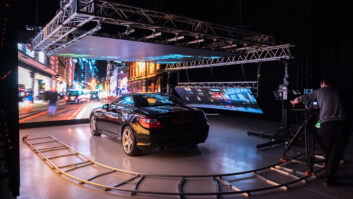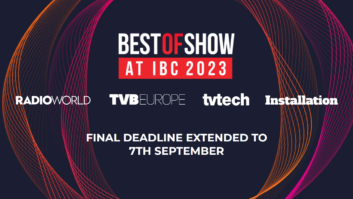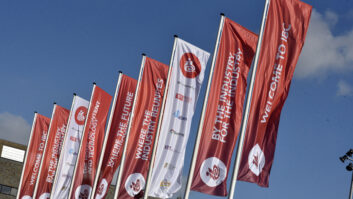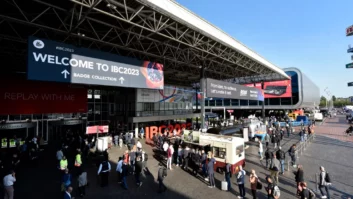The International Broadcasting Convention (IBC) has a long-established reputation as a showcase for the latest television and radio technology. In the last 20 years its remit has expanded to cover media as a whole, encompassing the growing areas of streaming and mobile. As part of this there has been an increasing crossover between the technologies used for broadcast and those in the AV sector. Part of this has been driven by the common use of IT-based infrastructures running IP audio and video systems, with the cloud adding an extra dimension for both sectors.
IBC returned to the physical world of the RAI Centre in Amsterdam last year after the pandemic forced the show online in virtual form. The 2022 event attracted 37,071 visitors from 170 countries, which was 32 percent down on the attendance for the last in-person IBC in 2019. There were 1000 exhibitors 12 months ago, and the organisers are hoping that figure will increase for 2023, with over 100 new exhibitors set to attend.
The show is as much known for its extensive sessions and conference programme as it is for the exhibition. The three themes for this year’s IBC are Transformative Tech, Shifting Business Models and People and Purpose. These will link the panel discussions, demonstrations, show floor theatres and the Changemakers Programme.
AV CROSSOVER
While still focused primarily on broadcast technology, many exhibitors will also be featuring technologies that crossover with AV, including virtual production, LED lighting and volumes and digital signage. Among the big name companies targeting both areas is Sony. During this year’s IBC it will demonstrate its Virtual Production Toolset software and Crystal LED displays, which are used to create 3D backgrounds to replace conventional sets. Sony will also be discussing its virtual systems on the IBC Innovation Stage on Saturday September 16 at 10am.
 Samsung similarly straddles both AV and broadcast, and claimed its stake in the virtual sector earlier this year with the launch of The Wall for Virtual Production. Based on its IVC series units, this set-up enables the creation of large-scale LED walls to produce content. The displays are integrated with real-time visual effects, which is said to reduce the time and cost of producing material, and also feature Black Seal Technology for purer black levels to deliver lifelike levels of texture, volume and a wide range of shades.
Samsung similarly straddles both AV and broadcast, and claimed its stake in the virtual sector earlier this year with the launch of The Wall for Virtual Production. Based on its IVC series units, this set-up enables the creation of large-scale LED walls to produce content. The displays are integrated with real-time visual effects, which is said to reduce the time and cost of producing material, and also feature Black Seal Technology for purer black levels to deliver lifelike levels of texture, volume and a wide range of shades.
As part of its IBC presentations, Samsung will be working with virtual staging specialists White Light (part of d&b solutions and developer of SmartStage) to demonstrate how IVC can be used in conjunction with specially made visual material. Samsung will also exhibit its latest touch-LED interactive displays, in collaboration with U-touch, and range of signage products.
Another established name in broadcast and 3D graphics is Brainstorm, which is also targeting its virtual studios at the AV sector. As part of its 30th birthday celebrations, the company will be demonstrating the InfinitySet extended, augmented and mixed reality (XR/AR/MR) platform in the Virtual Production Theatre. Features include photo-realistic scenes, produced through a mix of chroma sets and Alfalite’s shaped LED video walls; real-time, seamless extra-render and set extension; in-context AR motion graphics; fully immersive tele-transport; and multi-background content.
RECENT ADDITION
A more recent name on the LED/virtual scene is Brompton Technology, which has quickly established itself in both AV and broadcast over the last 11 years. This year at IBC it will introduce the new TrueLight LED processing system, which is aimed at panels with extra emitters, including RGBW, and situations where these are used as the lighting source. This includes virtual production volumes or theatre productions and fixed installations. TrueLight is based on Brompton’s Dynamic Calibration technology, which enables RGBW panels to be colour calibrated for each pixel and also gives the choice of what spectrum to use for the right look.
During the show, Brompton will be partnering with LED display manufacturer Absen as part of its immersive technologies demonstrations. It will also utilise filmmaking equipment from ARRI, stYpe’s camera tracking technology, Big Purple Productions’ management and esports systems, WhiteLight’s SmartStage XR platform (which will also be shown on the d&b solutions stand) and disguise’s media servers and live visuals. As well as this, Absen is to show its latest LED systems, along with demonstrations of live casting and the opportunity to take part in a game of Rocket League.
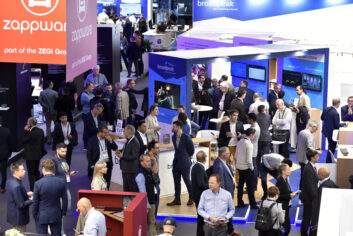 Another LED lighting developer, INFiLED, sees the new Brompton TrueLight and its own Infinite Colors technology as providing what it calls a new path for AV productions, combining colour control and virtual production processing. Infinite Colors adds a fourth emitter to the standard RGB (red, green, blue) format, which is said to increase the colour spectrum that can be seen by professional cameras. The technology is designed to produce a higher CRI (colour rendering index), resulting in more accurate reproduction of colours and textures. The first of INFiLED’s range to feature Infinite Colors is the Studio AR Series, which will be shown during IBC.
Another LED lighting developer, INFiLED, sees the new Brompton TrueLight and its own Infinite Colors technology as providing what it calls a new path for AV productions, combining colour control and virtual production processing. Infinite Colors adds a fourth emitter to the standard RGB (red, green, blue) format, which is said to increase the colour spectrum that can be seen by professional cameras. The technology is designed to produce a higher CRI (colour rendering index), resulting in more accurate reproduction of colours and textures. The first of INFiLED’s range to feature Infinite Colors is the Studio AR Series, which will be shown during IBC.
NEW ROUTE
ARRI is well known for its cameras, lenses and lighting systems, which are used extensively in feature film and TV drama production, but it now has a new route into the AV world after recently acquiring Claypaky. Already established in live performance, events and virtual production with its range of lights, Claypaky looks set to expand its user base further as part of the ARRI group. Both companies will be showing IP-based LEDs during IBC, while Claypaky will also display the moving lamps for which it is widely recognised.
Vizrt, together with its NewTek subsidiary (developer of the NDI network device interface), will highlight its full range of systems for corporate and AV live production, advanced XR sets, real-time graphics, sports production, including replay, cloud workflows and automation. During the show the Vizrt stand will host two recurring live shows: The Vizrt Experience and The TriCaster Anywhere Show.
There will also be demonstrations of the latest version of the Viz Engine 5 render and compositing system, which is able to integrate with Unreal Engine 5 to create photorealistic AR, VR and virtual sets. As well as this there will be the latest additions to the TriCaster range of live production packages.
CAMERA CROSSOVER
Another area that has long illustrated the crossover between AV and broadcast is cameras. Corporate presentations and live events use models that are the same or similar to those used in TV studios and for outside broadcasts (OBs). More recently, PTZ (pan, tilt, zoom) and POV (point-of-view) cameras have moved out of the industrial and security markets into AV and now broadcasting. IBC 2023 will reflect this, with a number of leading PTZ developers showing their latest products.
Telycam will demonstrate the Explore SE, a UHD PTZ camera with 4K60 resolution output through NDI|HX, HDMI2.0, and 12G-SDI. It is equipped with a 1/1.8-inch CMOS sensor, a 60-degree FOV (field of view) lens, Genlock, auto-tracking, Free-D positioning and supports a 30x optical zoom.
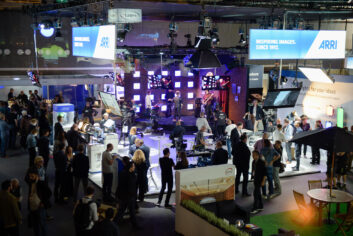 PTZOptics’ new range of cameras includes the Move 4K auto-tracking camera, which can support both 4K at 60 fps and 1080p at 60 fps over SDI; and the Link 4K Dante AV-H tracking camera, with all audio and video routing, configuration and device management accommodated within the one unit. PTZOptics’ new standard edition camera is the Move SE, which houses Sony CMOS sensors and offers a range of outputs for HDMI, SDI, USB and IP, plus the option to upgrade to NDI|HX. The new camera management platform (CMP) will be demonstrated, along with the Studio Pro camera, which is aimed at content creators.
PTZOptics’ new range of cameras includes the Move 4K auto-tracking camera, which can support both 4K at 60 fps and 1080p at 60 fps over SDI; and the Link 4K Dante AV-H tracking camera, with all audio and video routing, configuration and device management accommodated within the one unit. PTZOptics’ new standard edition camera is the Move SE, which houses Sony CMOS sensors and offers a range of outputs for HDMI, SDI, USB and IP, plus the option to upgrade to NDI|HX. The new camera management platform (CMP) will be demonstrated, along with the Studio Pro camera, which is aimed at content creators.
A new PTZ camera will be launched by BirdDog. The X120 is a lower cost model aimed at live production that offers a x20 zoom, WiFi connectivity, advanced colour controls and battery power options. The company will also be showing its integrated cloud-based platform for live production and post-production, with new features for tighter integration, simpler interfaces and improved workflows. Another debut is for BirdDog’s remote over-the-shoulder producer system based on the Adobe Premiere Pro video editing package. This includes real-time teleconferencing capability, in addition to interactive review and approval functionality.
Bolin Technology will highlight two models in its PTZ range aimed at two very specific applications: the R9 indoor camera and the outdoor EX–Ultra. Both are able to work in low light environments and offer advanced image stabilisation, up to two FPGA video processing engines (which produce three simultaneous, independent video streams), two 12G-SDI outputs, optical SDI and HDMI 2.0 and multiple IP streams. There will also be demonstrations of FAST HEVC, Bolin’s SDI quality video over IP system. As it is based on the HEVC open standard, it can be decoded by standard HEVC decoders, with a full FAST HEVC workflow achieved using the company’s EDGE Series EG40F decoding units.
COMPACT MODELS
On the POV side of the business, Marshall Electronics is to show the CV570 miniature and CV370 compact models. These feature a new Sony sensor that offers larger pixels and a square pixel array, which will be part of Marshall’s next generation of POV cameras, and have resolutions of up to 1920x1080p/1920x1080i and 1280x720p. The CV574 miniature and CV374 compact versions feature a new Sony 4K sensor, with all four cameras able to work at NDI|HX3 and NDI|HX2 in addition to standard IP with SRT and other streaming codec settings.
More traditional production-style cameras will be part of Blackmagic Design’s exhibit for IBC 2023. The Studio Camera range has scalable production levels for HD and UHD by employing HDMI, SDI or 10G Ethernet connectivity. By contrast, the URSA Broadcast G2 model is based on SMPTE fibre networks. Blackmagic Design will also be showing the ATEM live production switcher family, including the Constellation 8K and recently introduced Television Studio HD8 ISO.
CLOUD CHANGER
The cloud is as big a game-changer in AV as it is in broadcasting and IBC continues to reflect its importance. Magewell, which specialises in video and audio capture/conversion, will highlight two new products for this growing area of technology. ControlHub is able to operate on-premises – such as production facilities and control rooms – and in the cloud. It allows multiple encoders and decoders to be deployed across multiple, remote locations by using an intuitive browser interface, with the system able to remotely configure device settings, monitor device status and trigger encoding and other functions. ControlHub replaces the previous Magewell Cloud platform and can also be used for stream conversion of multiple protocols. The Pro Convert Audio DX is a multi-format audio encoder/decoder and capture unit and sees the first integration of Dante Audio over IP into a Magewell product.
 With extended workflows – something that is also being seen in AV work through more remote control of productions – there is an even greater need to ensure quality control (QC). Interra Systems will be showcasing its new BATON 9.0 engine, which includes upgrades to the BATON AI/ML-enabled automated QC platform. The latest updates for the BATON Media Player will also be on show, as well as additions to the AI-powered BATON Captions automated solution, including RHEL support.
With extended workflows – something that is also being seen in AV work through more remote control of productions – there is an even greater need to ensure quality control (QC). Interra Systems will be showcasing its new BATON 9.0 engine, which includes upgrades to the BATON AI/ML-enabled automated QC platform. The latest updates for the BATON Media Player will also be on show, as well as additions to the AI-powered BATON Captions automated solution, including RHEL support.
CLOSED CAPTIONS
Closed captions have long been a part of TV broadcasting but there is more pressure to subtitle as much programming as possible. With accessibility now a major consideration in all areas of life, closed captions have to be considered for corporate presentations and video in public places such as museums and visitor centres. ENCO is increasingly seeing its captioning systems used in AV situations. and this year introduced improvements to its enCaption5 system. These include achieving greater accuracy of up to 20 percent and upgraded speaker detection to enable more efficient captioning where more than one person is speaking. Also new is the enTranslate module, which can be used as part of enCaption. This supports 34 languages after the addition of a further 14, including Ukranian.
User interface control has always been important but it is even more so today with the increase in the number of devices and systems that can be involved on a production. KVM (keyboard, video, mouse) continues to offer flexibility for this, both as a direct interfacing system and as a background function. Guntermann & Drunck (G&D) will show its full range, including the new VisionXS range and PersonalWorkplace-Controller, which combines multiviewing and KVM. IHSE is joining forces with kvm-tec to show the respective benefits of proprietary KVM and KVM-over-IP, with the potential of using them together in hybrid situations to get the best of both.
Apantac is another leading KVM manufacturer, but during IBC will be focusing on its multiviewer ranges. These include the new compact NDI Multiviewer and the Mi16-DI Series, which are now able to accept full bandwidth NDI inputs.
LIVE PRODUCTION
On the audio front, Lawo will be highlighting the live production capabilities of its combined mc² mixing console and A__UHD Core/Power Core offering. New at IBC are the HOME Apps for the company’s HOME IP management platform. These include a Multiviewer, UDX Converter, Stream Transcoder and Graphic Inserter. Each is based on a flexible microservice architecture, and supports the main broadcast standards and protocols, including SMPTE ST 2110, SRT, JPEG XS and NDI.
Wireless microphones are as key to live AV productions as they are to broadcasting. Sennheiser will be showcasing the fifth generation of its Evolution systems, which include the EW-DP fully digital UHF wireless mic that now features a new portable design.
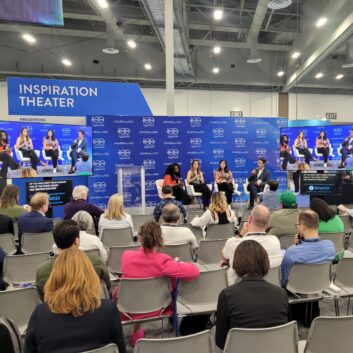 The EW-DP EK receiver offers a magnetic stacking system, which can be controlled remotely using the Smart Assist app. New for this year is the EW-DP SKP plug-on transmitter, due to be launched in late October. This is designed to turn any wired XLR microphone into a wireless unit and also features a recording function.
The EW-DP EK receiver offers a magnetic stacking system, which can be controlled remotely using the Smart Assist app. New for this year is the EW-DP SKP plug-on transmitter, due to be launched in late October. This is designed to turn any wired XLR microphone into a wireless unit and also features a recording function.
Sound Devices is to highlight the latest additions to its Astral range of wireless products, which is intended to be a complete ecosystem of devices to streamline wireless audio processes. Among these are the A20-TX digital wireless body pack transmitter, A20-Nexus and A20-Nexus Go multichannel true diversity wireless receivers, which have 169-1525 MHz global tuning range through Sound Devices’ proprietary SpectraBand technology.
In the last few years wireless mic manufacturers have been introducing technologies to optimise reduced frequency spectrum. To this end Shure will demonstrate the Axient Digital AD600 spectrum manager, WAVETOOL and the recent upgrade to Shure Software, the Wireless Workbench 7.
AoIP is now well-established in both AV and broadcast, with Audinate Dante as the dominant format. During IBC, Audinate will show Dante Connect, a suite of software applications for cloud-based broadcast production, and the Dante AV range of hardware and software systems that enable manufacturers and end users to add networked video to the Dante platform.
INTERCOM AUDIO
Intercom is an area of audio where IP has made a particular impact, which is reflected in major manufacturers continuing to introduce products featuring the technology. Clear-Com’s latest advances in IP include the Eclipse HX Digital Matrix intercom system, which includes Dynam-EC real-time production software and the new 2X10 Touch desktop touchscreen panel. Demos will be given of the IP-based Arcadia Central Station, key to which is the HXII-DPL Powerline IP interface that connects Arcadia to a HelixNet digital network systems.
RTS is moving on with IP through the DSPK-4 digital speaker station, a new addition to the Digital Partyline range. The DSPK-4 is an IP-based wired speaker station with four channels of talk/listen. Users are able to work using either a microphone and speaker set-up or headset, connecting over standard Ethernet or, in the case of headsets, Bluetooth. The DSPK-4 can be used as either a digital party line device and connects to an OMS (OMNEO Main Station) or a matrix key panel for point-to-point communications.
Overall, expect to see more traditional AV-facing manufacturers promoting their broadcast products at IBC 2023, as the lines between AV and broadcast continue to blur.
IBC 2023: September 15-18 at the Amsterdam RAI.
